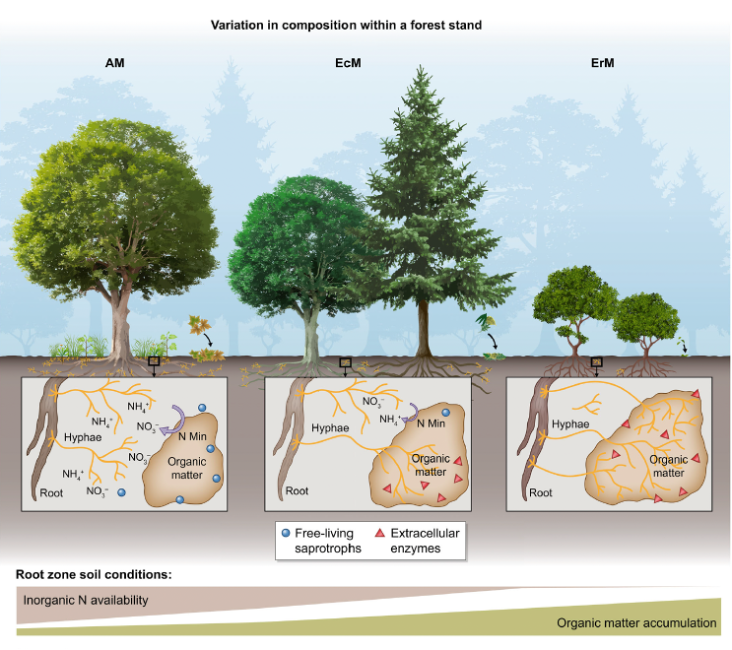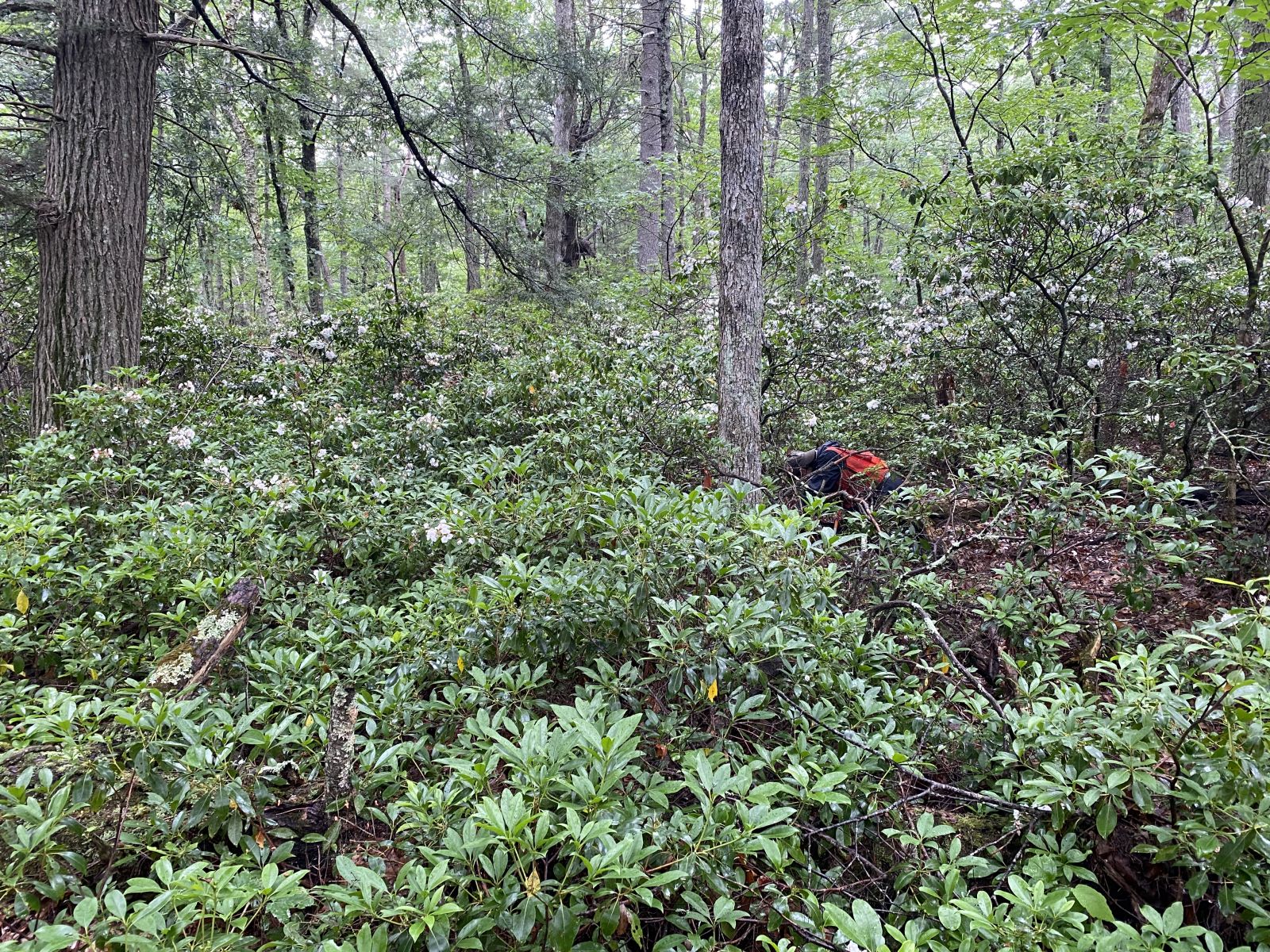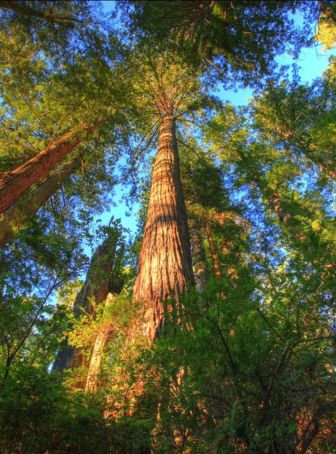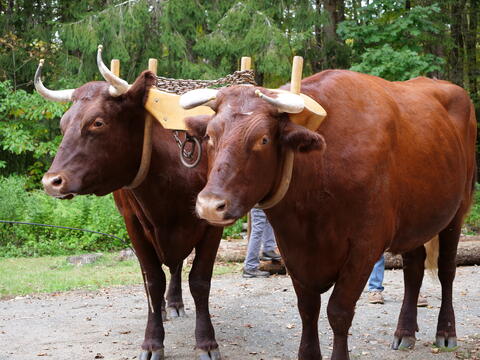
Eli Ward ’18 MFS is a fifth-year PhD candidate at The Forest School at the School of the Environment. Her research focuses on plant-soil interactions and their effects on carbon and nitrogen cycling and storage. More specifically, her dissertation explores how interactions between under- and over-story plant mycorrhizal associations affect forest carbon and nitrogen dynamics. For the past few years, she has explored this question at Yale-Myers Forest by studying the effects of mountain laurel since it associates with a different type of symbiotic fungi than most trees (read more about her work on mountain laurel).
For this Q&A, we are discussing one of her recent publications appearing in the New Phytologist, “The functional role of ericoid mycorrhizal plants and fungi on carbon and nitrogen dynamics in forests,” which is co-authored by three TFS faculty: Professor of Soils and Ecosystem Ecology Mark Bradford, Associate Research Scientist Marlyse Duguid, and Research Scientist Sara Kuebbing.
What are mycorrhizal fungi? Why are they important?
Mycorrhizal fungi are fungi that form symbiotic relationships with plants. Plants provide the fungal partner with carbon from photosynthesis as a source of energy, and the fungi provide the plants with greater access to water and nutrients from the soil. The evolution of this symbiotic relationship is thought to have enabled plants to first grow on land, and this happened before the evolution of roots. Most mycorrhizal fungi only grow underground and look a lot like plant roots. There are only a few species of mycorrhizal fungi that form the mushrooms that we most commonly associate with fungi.
Could you describe the differences between AM, EcM, and ErM fungi?
There are different types of mycorrhizal fungi that provide plants with access to soil resources in different ways. The oldest lineage—arbuscular mycorrhizal (AM) fungi—acts a lot like an extension of plant roots. They increase the surface area from which plants can obtain resources from the soil, but they only access nutrients in a form that is already available to plants (in the soil water solution). Ectomycorrhizal (EcM) and ericoid mycorrhizal (ErM) fungi, on the other hand, evolved from fungal decomposers, and some of these species are able to acquire nutrients from organic matter—a form of nutrients that would otherwise be unavailable to plants without the help of the decomposing abilities of their mycorrhizal fungi.

Figure 1: The three main types of mycorrhizal fungi discussed in the paper—arbuscular (AM), ecto- (EcM), and ericoid (ErM) mycorrhizal fungi—are each associated with different plant growth forms and nutrient acquisition strategies, which can influence ecosystem-scale carbon and nitrogen cycling. Figure from Ward et al. (2022).
What makes you focus on the third in this study and in your previous work? What makes ErM the star of the show?
There is a tendency for forest ecologists to focus on the effects of trees over understory plants, and nearly all tree species associate with AM and EcM fungi. Ericoid mycorrhizal fungi, on the other hand, associate with understory shrubs in the family Ericaceae, such as mountain laurel, blueberries, and huckleberries, so the effects of their mycorrhizal fungi on soil carbon and nitrogen cycling are often ignored. Importantly, shrubs and trees also co-occur, so the presence of understory ErM shrubs could also change what we might expect based on the mycorrhizal associations of tree species only.
How do the dominant types of mycorrhizal fungi determine what is happening in belowground carbon storage? What are the important pathways for them to alter and influence the accumulation and limitation of nutrients, especially carbon and nitrogen?
Mycorrhizal fungi are not the only type of fungi present in the soil. All the fungal decomposers that rely on soil organic matter for their nutrition also coexist with them. One way that EcM and ErM fungi can change carbon and nitrogen cycling in soils is by competing with fungal decomposers for limited organic resources. If the mycorrhizal fungi successfully outcompete fungal decomposers for resources in organic matter (like nitrogen), the rate of decomposition and nutrient cycling can be slowed.

Figure 2: Eli Ward’s research explores how interactions between co-occurring understory ericoid mycorrhizal (ErM) shrubs, such as mountain laurel, can alter predictions of soil carbon and nitrogen dynamics based on arbuscular (AM) versus ectomycorrhizal (EcM) tree associations alone. Figure from Ward et al. (2022).
What does it mean to have more persistent soil organic matter (SOM) in certain forest types? Why is this important?
Not all soil carbon is equal. Some soil carbon is readily accessible to microbes and can therefore easily be consumed and respired as carbon dioxide, leading to losses in soil carbon stocks over time. Other forms of soil carbon are less easily accessible to microbes and can therefore be considered a more stable, long-term soil carbon pool. These different forms of soil carbon therefore have vastly different implications for the climate mitigation potential of forest soils.
You examine the biogeography of AM, EcM, and ErM plants across different forest types globally. What are your main takeaways? What role does context play in understanding these varying relationships?
The global distribution of the different types of mycorrhizal fungi are strongly associated with climate. This is because colder sites (like the boreal forest) have a greater accumulation of organic matter in the soil, so plants need to have relationships with mycorrhizal fungi that can help them access this otherwise inaccessible pool of nutrients.
We also can’t assume that all ecosystems will work the same way. Therefore, another big takeaway from this part of the paper is highlighting the need to test these relationships in ecosystems that are less well-studied, such as tropical forests.
Either in your own future research or the research in this field more broadly, what are important questions and gaps to explore? What are you excited about?
There has been so much recent work that has explored how a single, dominant type of mycorrhizal fungi present in an ecosystem can affect soil carbon and nitrogen cycling. In reality, however, species most often occur in mixtures, and I’m really excited for this field to move forward into exploring how interactions between multiple, co-occurring types of mycorrhizal fungi influence these dynamics. My work has focused on this question in a temperate forest that includes AM and EcM trees as well as understory ErM shrubs, but there are other global ecosystems (e.g., the Mediterranean) where multiple mycorrhizal types co-occur where we can ask similar questions.

Eli Ward samples soils under a dense thicket of the ErM shrub mountain laurel at Yale-Myers Forest. Photo courtesy of Mark Bradford.
Follow Eli’s work:
Twitter: @elibward
Website: elisabethward.weebly.com
References:
Ward, E. B., Duguid, M. C., Kuebbing, S. E., Lendemer, J. C., & Bradford, M. A. (2022). The functional role of ericoid mycorrhizal plants and fungi on carbon and nitrogen dynamics in forests. New Phytologist.
Ward, E. B., Duguid, M. C., Kuebbing, S. E., Lendemer, J. C., Warren II, R. J., & Bradford, M. A. (2021). Ericoid mycorrhizal shrubs alter the relationship between tree mycorrhizal dominance and soil carbon and nitrogen. Journal of Ecology.
Previous writing in The Overstory newsletter: What Can Mountain Laurel Tell Us About Forest Soil Carbon? https://yff.yale.edu/news/what-can-mountain-laurel-tell-us-about-forest-soil-carbon







